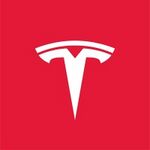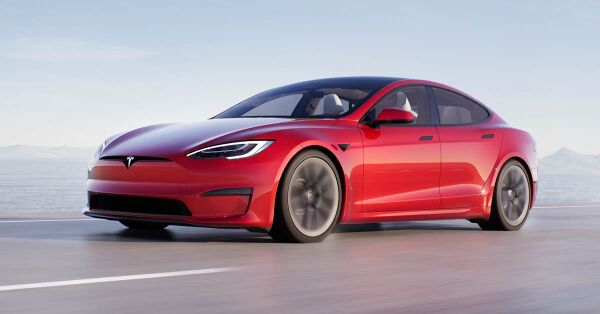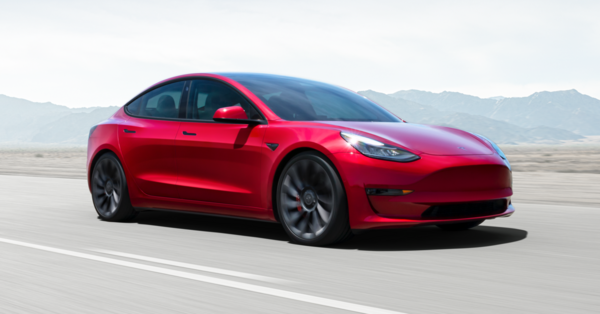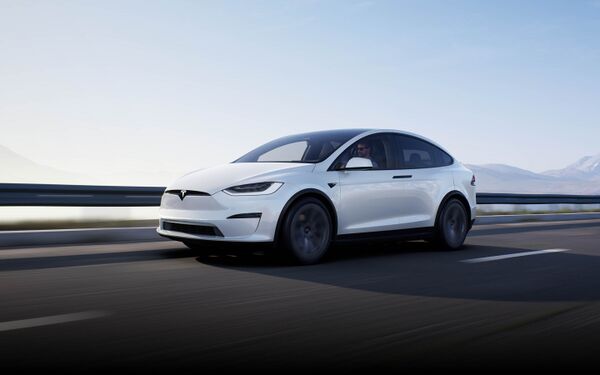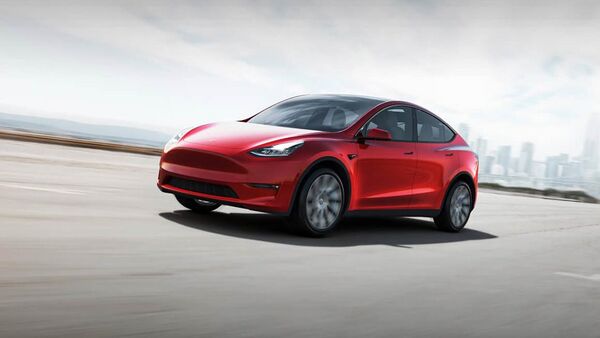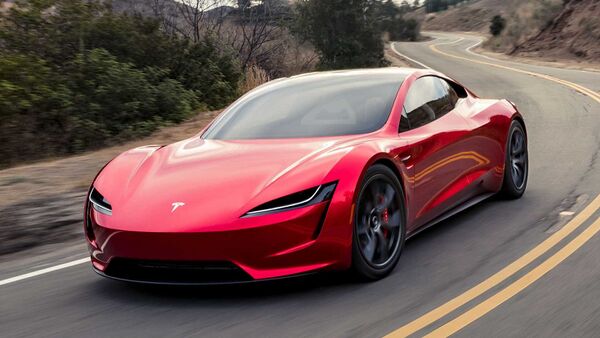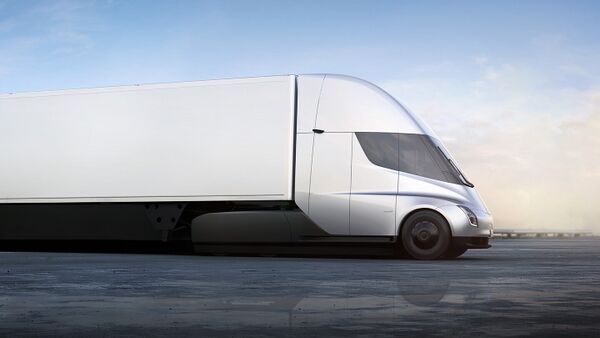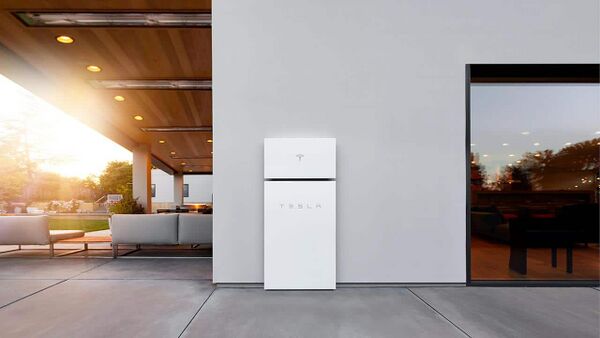Helping to accelerate the world's transition to sustainable energy.
| Risk/return | High |
| Price per share | $663.90 |
| Asset class | Equities |
| Industry | Consumer Cyclical |
| Country of incorporation | United States |
| Minimum investment amount | $10 |
| Maximum investment amount | $687.81 billion |
| Current valuation | $687.81 billion |
| Investor type | All |
| Tax schemes | None |
| Bid/ask spread (%) | 0.0015063% |
| Commission amount | N/A |
| Market | Public |
Summary
- Tesla is on a mission to accelerate the world's transition to sustainable energy.
- The Stockhub company estimates that the expected return of an investment in the company over the next five years is 4.4x. In other words, an £1,000 investment in the company is expected to return £4,400 in five years time.
Operations
What's the mission of the company?
Tesla is a company that's on a mission to accelerate the world's transition to sustainable energy.
What's the main offerings of the company?
The company operates in two main segments: (i) automotive and (ii) energy generation and storage.
Automotive
The automotive segment includes the design, development, manufacturing, sales and leasing of electric vehicles as well as sales of automotive regulatory credits. Additionally, the automotive segment is also comprised of services and other, which includes non-warranty after-sales vehicle services, sales of used vehicles, retail merchandise, sales by the company's acquired subsidiaries to third party customers and vehicle insurance revenue.
Current offerings
Model S
What is the offering?
Model S is an electric car.
What’s unique about the offering?
Model S is a four-door full-size sedan, and it features the highest performance characteristics and longest ranges that the company offers in a sedan.
| Model S | Model 3 | Model X | Model Y | |
|---|---|---|---|---|
| Is it fully electric? | Yes | Yes | Yes | Yes |
| Acceleration? | 3.1 seconds | 4.2 seconds | 3.8 seconds | 4.8 seconds |
| Range? | 375 miles | 334 miles | 332 miles | 318 miles |
| Top speed? | 155 miler per hour | 145 miles per hour | 155 miles per hour | 135 miles per hour |
| Beautiful? | Yes | Yes | Yes | Yes |
| Safe? | Yes | Yes | Yes | Yes |
| Price? | $99,990 | $46,990 | $114,990 | $62,990 |
What is the price of the offering?
The price of the car in the US is $99,990.
From which place(s) is the offering able to be purchased?
The main places that the offering is able to be purchased is through the company's website and company's stores.
From which place(s) is the offering promoted?
The main way that Tesla promotes the offering is through media coverage and word of mouth.
Model 3
What is the offering?
Model 3 is an electric car.
What’s unique about the offering?
Model 3 is a four-door mid-size sedan that is designed for manufacturability with a base price for mass-market appeal.
Note, a sedan is a car with a closed body (i.e. a fixed metal roof) with the engine, passengers, and cargo in separate compartments.
What is the price of the offering?
The price of the car in the US is $46,990.
From which place(s) is the offering able to be purchased?
The main places that the offering is able to be purchased is through the company's website and company's stores.
From which place(s) is the offering promoted?
The main way that Tesla promotes the offering is through media coverage and word of mouth.
Model X
What is the offering?
Model X is an electric car.
What’s unique about the offering?
Model X is a mid-size SUV with seating for up to seven adults, and it features the highest performance characteristics and longest ranges that the company offers in a SUV.
What is the price of the offering?
The price of the car in the US is $114,990.
From which place(s) is the offering able to be purchased?
The main places that the offering is able to be purchased is through the company's website and company's stores.
From which place(s) is the offering promoted?
The main way that Tesla promotes the offering is through media coverage and word of mouth.
Model Y
What is the offering?
Model Y is an electric car.
What’s unique about the offering?
Model Y is a compact sport utility vehicle (“SUV”) built on the Model 3 platform with seating for up to seven adults.
Note: a SUV is a car classification that combines elements of road-going passenger cars with features from off-road vehicles, such as raised ground clearance and four-wheel drive.
What is the price of the offering?
The price of the car in the US is $62,990.
From which place(s) is the offering able to be purchased?
The main places that the offering is able to be purchased is through the company's website and company's stores.
From which place(s) is the offering promoted?
The main way that Tesla promotes the offering is through media coverage and word of mouth.
Future offerings
Cybertruck
What is the offering?
What’s unique about the offering?
What is the price of the offering?
Information about the expected price of the product has yet to be disclosed.
From which place(s) is the offering able to be purchased?
The main places that the offering is likely to be able to be purchased is through the company's website and company's stores.
From which place(s) is the offering promoted?
The main way that Tesla is expected to promote the offering is through media coverage and word of mouth.
Tesla Roadster
What is the offering?
What’s unique about the offering?
What is the price of the offering?
Information about the expected price of the product has yet to be disclosed.
From which place(s) is the offering able to be purchased?
The main places that the offering is likely to be able to be purchased is through the company's website and company's stores.
From which place(s) is the offering promoted?
The main way that Tesla is expected to promote the offering is through media coverage and word of mouth.
Tesla Semi
What is the offering?
Tesla Semi is a truck.
What’s unique about the offering?
What makes the truck unique is that it's the world’s safest and most comfortable truck.[1]
What is the price of the offering?
Information about the expected price of the product has yet to be disclosed.
From which place(s) is the offering able to be purchased?
The main places that the offering is likely to be able to be purchased is through the company's website and company's stores.
From which place(s) is the offering promoted?
The main way that Tesla is expected to promote the offering is through media coverage and word of mouth.
Ride-hailing service
What is the offering?
Tesla has said that it intends to establish an autonomous Tesla ride-hailing network, enabling people to hail a ride.
What’s unique about the offering?
What is the price of the offering?
Information about the expected price of the service has yet to be disclosed.
From which place(s) is the offering able to be purchased?
From which place(s) is the offering promoted?
Energy generation and storage
The energy generation and storage segment includes the design, manufacture, installation, sales and leasing of solar energy generation and energy storage products and related services and sales of solar energy systems incentives.
Powerwall
What is the offering?
Powerwall is a home energy storage system (i.e. a type of battery).
What’s unique about the offering?
What is the price of the offering?
From which place(s) is the offering able to be purchased?
From which place(s) is the offering promoted?
Megapack
What is the offering?
Megapack is an industrial energy storage system.
What’s unique about the offering?
What is the price of the offering?
From which place(s) is the offering able to be purchased?
From which place(s) is the offering promoted?
Solar Roof
What is the offering?
Solar Roof is a roof tile.
What’s unique about the offering?
What makes the tile unique is that it's the most aesthetically-beautiful, energy generation roof tile. In other words, it's the most beautiful roof tile that generates electricity.
| Header text | Solar Roof | Traditional roof tile | Other solar-energy generation roof tile |
|---|---|---|---|
| Does it generate electricity? | Yes | No | Yes |
| Is it aesthetically beautiful? | Yes | Yes | No |
What is the price of the offering?
There is no information on the price of the offering within the public domain.
From which place(s) is the offering able to be purchased?
From which place(s) is the offering promoted?
Market
Total Addressable Market
Here, the total addressable market (TAM) is defined as the global sustainable energy market, and based on a number of assumptions, it is estimated that the size of the market as of today (18th March 2022), in terms of revenue, is $890 billion.
Serviceable Available Market
Here, the serviceable available market (SAM) is defined as the global electric vehicle market, and based on a number of assumptions, it is estimated that the size of the market as of today (18th March 2022), in terms of revenue, is $200 billion.
Serviceable Obtainable Market
Here, the serviceable obtainable market (SOM) is defined as the United States electric vehicle market, and based on a number of assumptions, it is estimated that the size of the market as of today (18th March 2022), in terms of revenue, is $16 billion.
Competition
Automotive
Energy generation and storage
Energy Storage Systems
Tesla believes that the specifications and features of its products, its strong brand and the modular, scalable nature of its energy storage products give it a competitive advantage in its markets.
Solar Energy Systems
Team
Leadership
Chief Executive Officer
Elon Musk is the Chief Executive Officer of Tesla and has served the position since October 2008 and as a member of the Board since April 2004. Elon has also served as Chief Executive Officer, Chief Technology Officer and Chairman of Space Exploration Technologies Corporation, an advanced rocket and spacecraft manufacturing and services company (“SpaceX ”), since May 2002, and served as Chairman of the Board of SolarCity Corporation, a solar installation company, from July 2006 until its acquisition by Tesla in November 2016. Elon is also a founder of The Boring Company, an infrastructure company, and of Neuralink Corp., a company focused on developing brain-machine interfaces. Prior to SpaceX, Elon co-founded PayPal, an electronic payment system, which was acquired by eBay in October 2002, and Zip2 Corporation, a provider of Internet enterprise software and services, which was acquired by Compaq in March 1999. Elon has also served on the board of directors of Endeavor Group Holdings, Inc. since April 2021. Elon holds a B.A. in physics from the University of Pennsylvania and a B.S. in business from the Wharton School of the University of Pennsylvania.
Chief Financial Officer
Zachary Kirkhorn is Chief Financial Officer of Tesla and served the position since March 2019. Previously, Zach served in various finance positions continuously since joining Tesla in March 2010, other than between August 2011 and June 2013 during which he attended business school, including most recently as Vice President, Finance, Financial Planning and Business Operations from December 2018 to March 2019. Zach holds dual B.S.E. degrees in economics and mechanical engineering and applied mechanics from the University of Pennsylvania and an M.B.A. from Harvard University.
Senior Vice President
Andrew Baglino has served as Tesla's Senior Vice President, Powertrain and Energy Engineering since October 2019. Previously, Drew served in various engineering positions continuously since joining Tesla in March 2006. Drew holds a B.S. in electrical engineering from Stanford University.
Financials
What are the financial forecasts?
In keeping in-line with industry standards, the number of years of financial forecasts shown below is five years.
Income statement
| Year/Item | Year 1 | Year 2 | Year 3 | Year 4 | Year 5 |
|---|---|---|---|---|---|
| Year end date | 31/12/2022 | 31/12/2023 | 31/12/2024 | 31/12/2025 | 31/12/2026 |
| Revenues (£'000) | £126.169 | £332.681 | £842.810 | £2,051.447 | £4,797.544 |
| Gross profits (£'000) | £100.935 | £266.145 | £674.248 | £1,641.158 | £3,838.035 |
| Operating profits (£'000) | £25.234 | £66.536 | £168.562 | £410.289 | £959.509 |
| Net profits (£'000) | £20.439 | £53.894 | £136.535 | £332.334 | £777.202 |
Balance sheet
Cash flow statement
What are the assumptions used to estimate the financial forecasts?
| Description | Value | Commentary |
|---|---|---|
Revenue
| ||
| What's the estimated current size of the total addressable market? | £954,000,000,000 | Here, the total addressable market (TAM) is defined as the global advertising market, and based on a number of assumptions[Note 2], it is estimated that the size of the market as of today (14th March 2022), in terms of revenue, is £635 billion (or $850 billion). |
| What's the estimated terminal annual growth rate of the total addressable market? | 3% | Research shows that the growth rate of the global advertising market (i.e. the total addressable market) is similar to the growth rate of global gross domestic product[3], which has averaged (medium) around 3% per year in the last 20 years (2001 to 2022)[4]. |
| What's the estimated company peak market share? | 2% | Research shows that there's an almost perfect positive correlation between the amount of adverting revenue generated on a platform and the total amount of time spent by users on the platform. In other words, the more time users spend on a platform, the more advertising revenue the platform generates. Accordingly, Stockhub believes that the best measurement unit of future advertising market share is time. In UK broadcasting, there's a limit on the amount of advertising that can be shown to viewers, and the limit is 15% of 24 hours (i.e. around 9 minutes per hour or around 216 minutes a day). Research suggests that Active Investors represent around 10.4% of the global population and that the average amount of time Active Investors spend researching investments is 30 minutes per day. Consequently, the Stockhub company estimates that the peak market share of its namesake platform is around 2%, and, therefore, suggests using the share amount here. |
| Which distribution function do you want to use to estimate company revenue? | Gaussian | Research suggests that the revenue pattern of companies is similar to the pattern produced by the Gaussian distribution function (i.e. the revenue distribution is bell shaped)[5], so Stockhub suggests using that function here. |
| What is the estimated company lifespan? | 50 years | Stockhub's vision is to be a large organisation (more than 10,000 employees), and research shows that the average lifespan of a large corporation is around 50 years.[6] |
| What's the estimated standard deviation of company revenue? | 5 years | Another way of asking this question is this way: within how many years either side of the mean does 68% of revenue occur? The Stockhub company suggests using 5 years (i.e. 68% of all sales happen within 5 years either side of the mean year), so that's what's used here. |
Growth stages
| ||
| How many main stages of growth is the company expected to go through? | 4 stages | Research suggests that a company typically goes through four distinct stages of cash flow growth.[7] Research also shows that incorporating those stages into the discounted cash flow model improves the quality of the model and, ultimately, the quality of the value estimation.[8]
In addition, research shows that a key way to determine the stage which a company is in is by examining the cash flow patterns of the company.[9] A summary of the economic links to cash flow patterns can be found in the appendix of this report. Stockhub estimates that with its operating and investing cash flows both negative (-) and its financing cash flows positive (+), the company is in the first stage of growth (i.e. the introduction stage), and, therefore, it has a total of four main stages of growth. |
| What proportion of the company lifecycle is represented by growth stage 1? | 34% | Research suggests 34%.[10] |
| What proportion of the company lifecycle is represented by growth stage 2? | 8% | Research suggests 8%.[10] |
| What proportion of the company lifecycle is represented by growth stage 3? | 16% | Research suggests 16%.[10] |
| What proportion of the company lifecycle is represented by growth stage 4? | 42% | Research suggests 42%.[10] |
Growth stage 1
| ||
| Cost of goods sold margin (%) | 20% | Research suggests that it's best to use a similar margin rate as the one used by peers that are in the same growth stage (i.e. growth stage 1)[11], and the margin for its peers was 20%. |
| Selling, General and Administrative expenses margin (%) | 80% | Research suggests that it's best to use a similar margin rate as the one used by peers that are in the same growth stage (i.e. growth stage 1)[11], and the margin for its peers was 80%. |
| Tax rate (%) | 19% | Research suggests that it's best to use the marginal tax rate of the country in which the company mainly operates. The Stockhub company mainly operates in the United Kingdom, and the marginal tax rate there is 19%. |
| Depreciation rate (%) | 10% | Research suggests that it's best to use a similar margin rate as the one used by peers that are in the same growth stage (i.e. growth stage 1)[11], and the margin for its peers was 10%. |
| Fixed capital margin (%) | 25% | Research suggests that it's best to use a similar margin rate as the one used by peers that are in the same growth stage (i.e. growth stage 1)[11], and the margin for its peers was 25%. |
| Change in working capital (£000) | Zero | Stockhub suggests that for simplicity, the change in working capital figure is zero. |
Growth stage 2
| ||
| Cost of goods sold margin (%) | 20% | Research suggests that it's best to use a similar margin rate as the one used by peers that are in the same growth stage (i.e. growth stage 2)[11], and the margin for its peers was 20%. |
| Selling, General and Administrative expenses margin (%) | 60% | Research suggests that it's best to use a similar margin rate as the one used by peers that are in the same growth stage (i.e. growth stage 2)[11], and the margin for its peers was 60%. |
| Tax rate (%) | 19% | Research suggests that it's best to use the marginal tax rate of the country in which the company mainly operates. The Stockhub company mainly operates in the United Kingdom, and the marginal tax rate there is 19%. |
| Depreciation rate (%) | 10% | Research suggests that it's best to use a similar margin rate as the one used by peers that are in the same growth stage (i.e. growth stage 2)[11], and the margin for its peers was 10%. |
| Fixed capital margin (%) | 25% | Research suggests that it's best to use a similar margin rate as the one used by peers that are in the same growth stage (i.e. growth stage 2)[11], and the margin for its peers was 25%. |
| Change in working capital (£000) | Zero | Stockhub suggests that for simplicity, the change in working capital figure is zero. |
Growth stage 3
| ||
| Cost of goods sold margin (%) | 20% | Research suggests that it's best to use a similar margin rate as the one used by peers that are in the same growth stage (i.e. growth stage 3)[11], and the margin for its peers was 20%. |
| Selling, General and Administrative expenses margin (%) | 40% | Research suggests that it's best to use a similar margin rate as the one used by peers that are in the same growth stage (i.e. growth stage 3)[11], and the margin for its peers was 40%. |
| Tax rate (%) | 19% | Research suggests that it's best to use the marginal tax rate of the country in which the company mainly operates. The Stockhub company mainly operates in the United Kingdom, and the marginal tax rate there is 19%. |
| Depreciation rate (%) | 10% | Research suggests that it's best to use a similar margin rate as the one used by peers that are in the same growth stage (i.e. growth stage 3)[11], and the margin for its peers was 10%. |
| Fixed capital margin (%) | 25% | Research suggests that it's best to use a similar margin rate as the one used by peers that are in the same growth stage (i.e. growth stage 3)[11], and the margin for its peers was 25%. |
| Change in working capital (£000) | Zero | Stockhub suggests that for simplicity, the change in working capital figure is zero. |
Growth stage 4
| ||
| Cost of goods sold margin (%) | 20% | Research suggests that it's best to use a similar margin rate as the one used by peers that are in the same growth stage (i.e. growth stage 4)[11], and the margin for its peers was 20%. |
| Selling, General and Administrative expenses margin (%) | 40% | Research suggests that it's best to use a similar margin rate as the one used by peers that are in the same growth stage (i.e. growth stage 4)[11], and the margin for its peers was 40%. |
| Tax rate (%) | 19% | Research suggests that it's best to use the marginal tax rate of the country in which the company mainly operates. The Stockhub company mainly operates in the United Kingdom, and the marginal tax rate there is 19%. |
| Depreciation rate (%) | 10% | Research suggests that it's best to use a similar margin rate as the one used by peers that are in the same growth stage (i.e. growth stage 4)[11], and the margin for its peers was 10%. |
| Fixed capital margin (%) | 25% | Research suggests that it's best to use a similar margin rate as the one used by peers that are in the same growth stage (i.e. growth stage 4)[11], and the margin for its peers was 25%. |
| Change in working capital (£000) | Zero | Stockhub suggests that for simplicity, the change in working capital figure is zero. |
Risks
- Tesla may be impacted by macroeconomic conditions resulting from the global COVID-19 pandemic.
- Tesla may experience delays in launching and ramping the production of its products and features, or Tesla may be unable to control its manufacturing costs.
- Tesla may be unable to grow its global product sales, delivery and installation capabilities and its servicing and vehicle charging networks, or Tesla may be unable to accurately project and effectively manage its growth.
- Tesla's future growth and success is dependent upon consumers’ demand for electric vehicles and specifically its vehicles in an automotive industry that is generally competitive, cyclical and volatile.
- Tesla's suppliers may fail to deliver components according to schedules, prices, quality and volumes that are acceptable to us, or Tesla may be unable to manage these components effectively.
- Tesla may be unable to meet its projected construction timelines, costs and production ramps at new factories, or Tesla may experience difficulties in generating and maintaining demand for products manufactured there.
- Tesla will need to maintain and significantly grow its access to battery cells, including through the development and manufacture of its own cells, and control its related costs.
- Tesla faces strong competition for its products and services from a growing list of established and new competitors.
- Tesla may experience issues with lithium-ion cells or other components manufactured at Gigafactory Nevada and Gigafactory Shanghai, which may harm the production and profitability of its vehicle and energy storage products.
- Tesla faces risks associated with maintaining and expanding its international operations, including unfavorable and uncertain regulatory, political, economic, tax and labor conditions.
- Tesla's business may suffer if its products or features contain defects, fail to perform as expected or take longer than expected to become fully functional.
- Tesla may be required to defend or insure against product liability claims.
- Tesla will need to maintain public credibility and confidence in its long-term business prospects in order to succeed.
- Tesla may be unable to effectively grow, or manage the compliance, residual value, financing and credit risks related to, its various financing programs.
- Tesla must manage ongoing obligations under its agreement with the Research Foundation for the State University of New York relating to its Gigafactory New York.
- If Tesla is unable to attract, hire and retain key employees and qualified personnel, its ability to compete may be harmed.
- Tesla is highly dependent on the services of Elon Musk, its Chief Executive Officer.
- Tesla's information technology systems or data, or those of its service providers or customers or users could be subject to cyber-attacks or other security incidents, which could result in data breaches, intellectual property theft, claims, litigation, regulatory investigations, significant liability, reputational damage and other adverse consequences.
- Any unauthorized control or manipulation of Tesla's products’ systems could result in loss of confidence in it and its products.
- Tesla's business may be adversely affected by any disruptions caused by union activities.
- Tesla may choose to or be compelled to undertake product recalls or take other similar actions.
- Tesla's current and future warranty reserves may be insufficient to cover future warranty claims.
- Tesla's insurance coverage strategy may not be adequate to protect it from all business risks.
- Tesla's debt agreements contain covenant restrictions that may limit its ability to operate its business.
- Additional funds may not be available to Tesla when it needs or want them.
- Tesla may be negatively impacted by any early obsolescence of its manufacturing equipment.
- Tesla holds and may acquire digital assets that may be subject to volatile market prices, impairment and unique risks of loss.
- There is no guarantee that Tesla will have sufficient cash flow from its business to pay its indebtedness or that it will not incur additional indebtedness.
- Tesla is exposed to fluctuations in currency exchange rates.
- Tesla may need to defend itself against intellectual property infringement claims, which may be time-consuming and expensive.
- Increased scrutiny and changing expectations from stakeholders with respect to the Company's ESG practices may result in additional costs or risks.
- Tesla's operations could be adversely affected by events outside of its control, such as natural disasters, wars or health epidemics.
- Demand for Tesla's products and services may be impacted by the status of government and economic incentives supporting the development and adoption of such products.
- Tesla is subject to evolving laws and regulations that could impose substantial costs, legal prohibitions or unfavourable changes upon its operations or products.
- Any failure by Tesla to comply with a variety of United States and international privacy and consumer protection laws may harm the company.
- Tesla could be subject to liability, penalties and other restrictive sanctions and adverse consequences arising out of certain governmental investigations and proceedings.
- Tesla may face regulatory challenges to or limitations on its ability to sell vehicles directly.
- The trading price of Tesla's common stock is likely to continue to be volatile.
- Tesla's financial results may vary significantly from period to period due to fluctuations in its operating costs and other factors.
- Tesla may fail to meet its publicly announced guidance or other expectations about its business, which could cause its stock price to decline.
- Transactions relating to Tesla's convertible senior notes may dilute the ownership interest of existing stockholders, or may otherwise depress the price of its common stock.
- If Elon Musk were forced to sell shares of Tesla's common stock that he has pledged to secure certain personal loan obligations, such sales could cause its stock price to decline.
- Anti-takeover provisions contained in Tesla's governing documents, applicable laws and its convertible senior notes could impair a takeover attempt.
Valuation
What's the expected return of an investment in the company?
The Stockhub company estimates that the expected return of an investment in the company over the next five years is 55x. In other words, an £1,000 investment in the company is expected to return £55,000 in five years time. The assumptions used to estimate the return figure can be found in the table below.
Assuming that a suitable return level over five years is 10% per year and Stockhub achieves its expected return level (of 55x), then an investment in the Stockhub company is considered to be a 'suitable' one.
For those in the UK: Stockhub is SEIS and EIS eligible, a key benefit of which is that those who invest now can claim back up to 50% of the investment amount in income tax relief. Accordingly, the estimated expected return of investing in the business is even higher for UK-citizens (than non-UK citizens).
What are the assumptions used to estimate the return?
| Description | Value | Commentary |
|---|---|---|
| Which valuation model do you want to use? | Discounted cash flow | There are two main approaches to estimate the value of an investment:
Research suggests that in terms of estimating the expected return of an investment over a period of 12-months or more, the approach that is more accurate is the discounted cash flow approach[12], so that's the approach that Stockhub suggests to use here; nevertheless, for completeness purposes, separately, the valuation of the company is also estimated using the using the relative valuation approach (the valuation based on the relative approach can be found in the appendix of this report). |
| Which financial forecasts to use? | Stockhub | The only available forecasts are the ones that are supplied by the Stockhub company (the forecasts can be found in the financials section of this report), so Stockhub suggests using those. |
Growth stage 1
| ||
| Discount rate (%) | 25% | There are two key risk parameters for a firm that need to be estimated: its cost of equity and its cost of debt. A key way to estimate the cost of equity is by looking at the beta (or betas) of the company in question, the cost of debt from a measure of default risk (an actual or synthetic rating) and apply the market value weights for debt and equity to come up with the cost of capital.
Research indicates that companies in the first stage of the business lifecycle are often held by either undiversified owners or by partially diversified venture capitalists.[11] Consequently, it does not make sense to assume that the only risk that should be priced in is the market risk; the cost of equity has to incorporate some (in the case of venture capitalists) or maybe even all (for completely undiversified owners) of the firm specific risk. |
| Probability of success (%) | 20% | Research suggests that a suitable rate for a company in this growth stage (i.e. stage 1) is 20%. |
Growth stage 2
| ||
| Discount rate (%) | 15% | There are two key risk parameters for a firm that need to be estimated: its cost of equity and its cost of debt. A key way to estimate the cost of equity by looking at the beta (or betas) of the company in question, the cost of debt from a measure of default risk (an actual or synthetic rating) and apply the market value weights for debt and equity to come up with the cost of capital. |
| Probability of success (%) | 50% | Research suggests that a suitable rate for a company in this growth stage (i.e. stage 2) is 50%. |
Growth stage 3
| ||
| Discount rate (%) | 10% | There are two key risk parameters for a firm that need to be estimated: its cost of equity and its cost of debt. A key way to estimate the cost of equity by looking at the beta (or betas) of the company in question, the cost of debt from a measure of default risk (an actual or synthetic rating) and apply the market value weights for debt and equity to come up with the cost of capital. |
| Probability of success (%) | 100% | Research suggests that a suitable rate for a company in this growth stage (i.e. stage 3) is 100%. |
Growth stage 4
| ||
| Discount rate (%) | 10% | There are two key risk parameters for a firm that need to be estimated: its cost of equity and its cost of debt. A key way to estimate the cost of equity by looking at the beta (or betas) of the company in question, the cost of debt from a measure of default risk (an actual or synthetic rating) and apply the market value weights for debt and equity to come up with the cost of capital. |
| Probability of success (%) | 100% | Research suggests that a suitable rate for a company in this growth stage (i.e. stage 4) is 100%. |
Other key inputs
| ||
| What's the current value of the company? | £4,000,000 | As at 23rd February 2022, the Stockhub company estimates the current value of its company at £4 million. |
| Which time period do you want to use to estimate the expected return? | Between now and five years time | Stockhub suggests that to account for general market cyclicity, it's best to estimate the expected return of the company between now and five years time. |
Sensitive analysis
The main inputs that result in the greatest change in the expected return of the Stockhub investment are, in order of importance (from highest to lowest):
- The discount rate (the default time-weighted average rate is 15%);
- The probability of success rate (the default time-weighted average rate is 71%); and
- Stockhub peak market share (the default share is 2%)
The impact of a 50% change in those main inputs to the expected return of the Stockhub investment is shown in the table below.
| Main input | 50% worse | Unchanged | 50% better |
|---|---|---|---|
| The discount rate | 10x | 55x | 412x |
| The probability of success rate | 14x | 55x | 88x |
| Stockhub peak market share | 27x | 55x | 82x |
Appendix
Relative valuation approach
What's the expected return of an investment in Tesla?
Accordingly, Stockhub estimates that the expected return of an investment in Tesla Inc over the next five years is 4.4x. In other words, an £1,000 investment in the company is expected to return £4,400 in five years time.
The return figure estimate is based on the following key assumptions: an industry (online advertising) standard growth-adjusted enterprise value/sales multiple of 89x, Stockhub's year-5 revenue estimate (of $82.8 billion), Stockhub's year-6 to year-8 compound annual growth rate estimate (of 53.80%), net cash of ccc and the current estimated company valuation (of $900.80 billion).
The calculation is as follows: (89 x $82.8 billion x 0.538) / $900.80 billion = 4.4x.
What are the assumptions used to estimate the return figure?
| Description | Value | Commentary |
|---|---|---|
| Which type of multiple do you want to use? | Growth-adjusted EV/sales | For the numerator, Stockhub believes that to account for the different financial leverage levels of its peers, it's best to use enterprise value (EV), rather than price. For the denominator, Stockhub believes that because it expects Tesla to reinvest almost all of its revenue back into the business over the five year forecast period and therefore its earnings are expected to be abnormally low over the period, it's best to use sales. Accordingly, Stockhub suggests valuing its company using the EV/sales ratio. However, Stockhub feels that to take into account the different business lifecycle stages of its peers, the most suitable valuation multiple to use is the growth-adjusted EV/sales multiple[Note 3], rather than the EV/sales multiple. |
| In regards to the growth-adjusted EV/sales multiple, for the sales figure, which year to you want to use? | Year 5 | Stockhub suggests that with sales forecast to grow exponential over the five year forecast period, it's best to use forward-looking data, rather than historic data.
|
| In regards to the growth-adjusted EV/sales multiple, for the sales growth figure, which year(s) do you want to use? | Year 6 to 8, from now | Stockhub suggests that for the sales growth figure, it's best to use Year 6 to 8. |
| In regards to the growth-adjusted EV/sales multiple, what multiple figure do you want to use? | 89x | In Stockhub's view, Tesla closest peer is Apple. Apple trades on a multiple of 89x. |
| Which financial forecasts to use? | Stockhub | The only available forecasts are the ones that are supplied by the Stockhub company (the forecasts can be found in the financials section of this report), so Stockhub suggests using those. |
| What's the current value of the Stockhub company? | $688 billion | As at 21st May 2022, the current value of its company at $688 billion. |
| Which time period do you want to use to estimate the expected return? | Between now and five years time | Stockhub suggests that to account for general market cyclicity, it's best to estimate the expected return of the company between now and five years time. |
Tesla peer(s)
| Investments | Industry | Enterprise value/sales | 1-year forward revenue growth rates (%) | Growth-adjusted enterprise value/sales ratio |
|---|---|---|---|---|
| Apple Inc. | Internet content & communication | 7.27x[13] | 8.20%[13] | 89x |
Notes
Bid-ask spread
The bid–ask spread is the difference between the prices quoted for an immediate sale (ask) and an immediate purchase (bid) for the investment.
For example, if the price to buy an investment is $663.90 and the price to sell the investment is $663.89, the bid-ask spread of the investment is $0.01 (i.e.$663.90 minus $663.89). Converting the figure into percentage, the bid-ask spread is 0.0015063% (i.e. $0.01 divided by $663.90).
Actions
To invest in Tesla, click here.
To contact Tesla, click here.
References
- ↑ https://www.tesla.com/en_GB/semi
- ↑ Source: Stockhub Limited
- ↑ http://www.robertpicard.net/files/econgrowthandadvertising.pdf
- ↑ https://www.macrotrends.net/countries/WLD/world/gdp-growth-rate
- ↑ http://escml.umd.edu/Papers/ObsCPMT.pdf
- ↑ Stadler, Enduring Success, 3–5.
- ↑ Levie J, Lichtenstein BB (2010) A terminal assessment of stages theory: Introducing a dynamic approach to entrepreneurship. Entrepreneurship: Theory & Practice 34(2): 317–350. https://doi.org/10.1111/j.1540-6520.2010.00377.x
- ↑ Stef Hinfelaar et al.:, 2019.
- ↑ Dickinson, 2010.
- ↑ 10.0 10.1 10.2 10.3 http://escml.umd.edu/Papers/ObsCPMT.pdf
- ↑ 11.00 11.01 11.02 11.03 11.04 11.05 11.06 11.07 11.08 11.09 11.10 11.11 11.12 11.13 11.14 11.15 11.16 http://people.stern.nyu.edu/adamodar/pdfiles/papers/younggrowth.pdf
- ↑ Demirakos et al., 2010; Gleason et al., 2013
- ↑ 13.0 13.1 Morningstar, Inc.
Cite error: <ref> tags exist for a group named "Note", but no corresponding <references group="Note"/> tag was found
